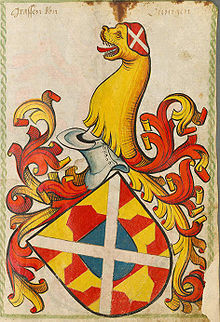Irmengard of Oettingen
| Irmengard of Oettingen | |
|---|---|

Family coat of arms of the Counts of Oettingen
|
|
| Spouse(s) | Adolf, Count Palatine of the Rhine |
| Noble family | House of Oettingen |
| Father | Count Louis VI of Oettingen |
| Mother | Agnes of Württemberg |
| Born | c. 1304 |
| Died | 6 November 1389 Worms, Germany |
| Buried | Liebenau monastery in Worms |
Irmengard of Oettingen (c. 1304 – 6 November 1389 in Worms, Germany) was a princess of the Counts von Oettingen by birth, and by marriage, Countess Palatine of the Rhine and, as a widow, a Dominican nun.
Irmengard of Oettingen was the daughter of Count Louis VI of Oettingen (1288–1346) and his wife Agnes of Württemberg (1295–1317), a daughter of Eberhard the Illustrious, of Württemberg.
In 1320 Princess Irmengard married Count Palatine Adolph "the Upright" of Wittelsbach. He was officially the Count Palatine of the Rhine from 1319 until his death in 1327. The actual power of government, however, was exercised by his uncle Louis IV.
The couple resided in Heidelberg under the suzerainty of Emperor Louis IV. In 1326, they retired to Oggersheim. This community had been destroyed by fire. Adolf led the rebuild and added a city wall and a moat and elevated the place to a city. Adolf died in January 1327 in Neustadt an der Weinstraße and was buried in the Cistercian Schönau Abbey.
Irmengard of Oettingen and Count Palatine Adolf had four children:
Still in the year of death of her husband, countess Irmengard and her children retired into the Liebenau monastery in Worms. The Austria-minded Count John of Nassau was appointed as the children's guardian. The Treaty of Pavia (1329) between Emperor Louis IV and Adolf's brothers Electors Palatine Rudolf II and Rupert I was concluded, stipulating that Adolf's four-year-old son Rupert II would succeed his childless uncles as Count Palatine and Elector.
...
Wikipedia
